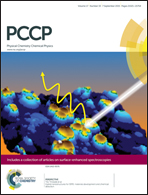Calculating average surface enhancement factors of randomly nanostructured electrodes by a combination of SERS and impedance spectroscopy†
Abstract
Polyhedron Ag nanostructures were created on top of a polished Au electrode via step-wise electrodeposition and tested as substrates for SERS spectroscopy. Average Raman enhancement factors were derived by combining SERS measurements with electrochemical impedance spectroscopy (EIS), which is able to determine the electroactive surface area of a randomly nanostructured surface. Depending on the deposition step an alternating increase and decrease of surface area was observed while the SERS intensity showed a clear maximum for the first deposition cycle. SEM pictures reveal the formation of Ag polyhedrons that are randomly dispersed on the Au surface. Furthermore the presence of a sub nanostructure on top of the polyhedron after the first deposition cycle is observed which becomes smoother after subsequent deposition cycles. Correlating the SEM pictures with SERS and EIS measurements it is concluded that the coral-like sub nanostructure is dominating the enhancement factor while the polyhedron structure itself only plays a minor role for electromagnetic field enhancement.

- This article is part of the themed collection: Surface-enhanced spectroscopies

 Please wait while we load your content...
Please wait while we load your content...